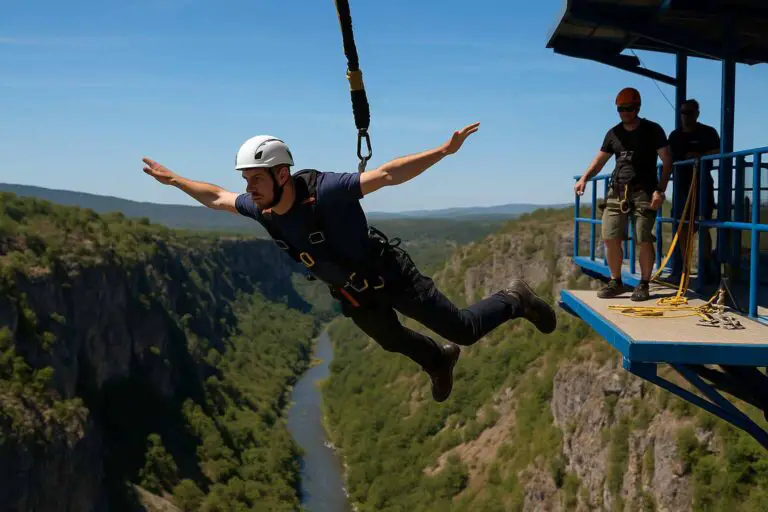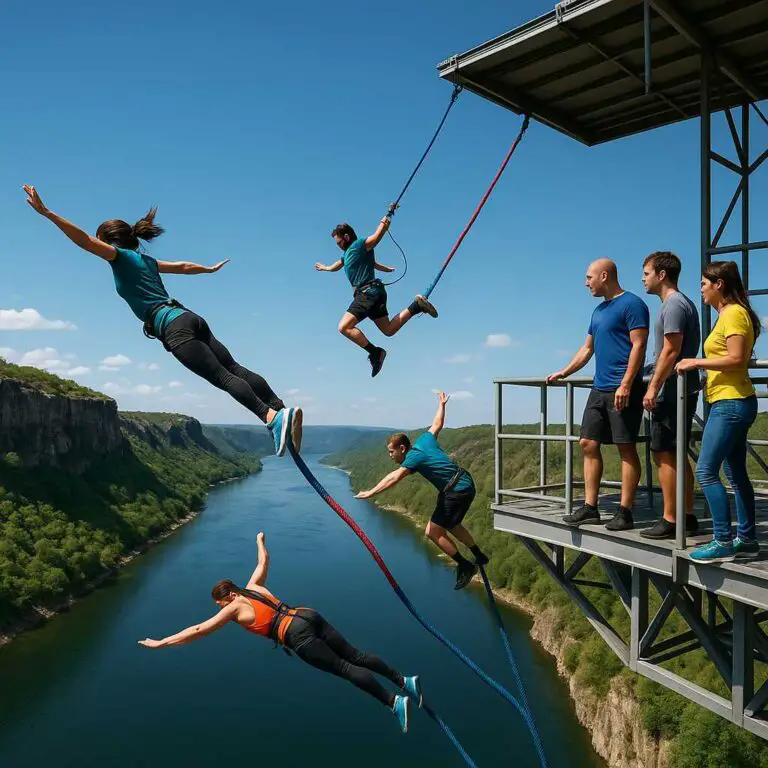Extreme sports have gained immense popularity over the years, offering an adrenaline rush like no other. These activities are not for the faint-hearted, as they often involve significant risks and challenges that push individuals to their limits. Among the many extreme sports that exist, bungee jumping stands out as one of the most iconic and thrilling experiences.
In this comprehensive comparative analysis, we will explore bungee jumping in depth and compare it to several other extreme sports, shedding light on the unique characteristics, safety considerations, and the psychological appeal of each.
Understanding Bungee Jumping
The Thrill of Free Falling
Bungee jumping is an extreme sport that involves leaping from a great height, usually a bridge or a platform, while being connected to a strong elastic cord. The jumper experiences a free fall before the cord stretches and propels them upward, creating a pendulum-like motion until they come to a controlled stop. The sensation of falling, followed by the sudden rebound, makes bungee jumping an exhilarating experience that many thrill-seekers find irresistible.
Safety Measures in Bungee Jumping
Safety is paramount in bungee jumping. Operators follow strict protocols to ensure the well-being of participants. Here are some key safety measures:
- Equipment Inspection: Before each jump, all equipment, including the bungee cord, harnesses, and attachment points, undergoes rigorous inspection to ensure they are in perfect condition.
- Certified Instructors: Trained and certified instructors guide participants through the process, from the safety briefing to the actual jump.
- Weight Limits: Weight limits are imposed to ensure the bungee cord’s effectiveness and prevent overstretching, which can lead to injury.
- Height and Distance Calculations: The height from which the jump takes place and the length of the cord are carefully calculated to ensure a safe landing distance.
- Medical Assessments: Some operators may require participants to undergo medical assessments to identify any health conditions that could pose risks.
Comparing Bungee Jumping to Other Extreme Sports
To provide a comprehensive comparative analysis, we’ll compare bungee jumping to other popular extreme sports, including skydiving, rock climbing, BASE jumping, and white-water rafting. Each sport offers unique challenges, experiences, and appeals, making them popular choices for adrenaline junkies.
1. Bungee Jumping vs. Skydiving
Bungee Jumping:
- Location: Typically performed from fixed platforms like bridges or cranes.
- Free Fall: Short, intense free fall followed by a rebound.
- Equipment: Uses a bungee cord and harness.
- Accessibility: Requires less training and preparation compared to skydiving.
- Cost: Generally more affordable.
Skydiving:
- Location: Takes place in mid-air from an airplane.
- Free Fall: Longer free fall at high altitude.
- Equipment: Involves parachutes and specialized jumpsuits.
- Accessibility: Requires extensive training, certification, and often more planning.
- Cost: Generally more expensive due to equipment and training costs.
Analysis: Bungee jumping offers a quick and accessible way to experience the thrill of free fall, making it suitable for beginners or those looking for a spontaneous adventure. In contrast, skydiving provides a longer free fall experience, requiring more commitment in terms of training and preparation.
2. Bungee Jumping vs. Rock Climbing
Bungee Jumping:
- Intensity: High-intensity during the jump itself.
- Physical Demand: Minimal physical effort, aside from the jump.
- Safety: Risks primarily associated with equipment failure.
Rock Climbing:
- Intensity: Sustained intensity throughout the climb.
- Physical Demand: Requires strength, endurance, and technique.
- Safety: Risks include falls, equipment failure, and environmental factors.
Analysis: Bungee jumping provides an intense rush during the jump but minimal physical effort. Rock climbing, on the other hand, demands physical prowess and mental focus throughout the climb. The choice between the two depends on an individual’s preferences for intensity and physical engagement.
3. Bungee Jumping vs. BASE Jumping
Bungee Jumping:
- Location: Fixed platforms like bridges or cranes.
- Equipment: Utilizes a bungee cord and harness.
- Regulations: More standardized and regulated.
BASE Jumping:
- Location: Various fixed objects, including buildings, cliffs, and antennas.
- Equipment: Requires specialized wingsuits, parachutes, and experience.
- Regulations: Less standardized and more niche, often requiring specific permits.
Analysis: Both bungee jumping and BASE jumping involve leaping from heights, but BASE jumping presents higher risks due to the need for specialized equipment and greater skill. Bungee jumping is a safer alternative for those seeking a similar experience without extensive training.
4. Bungee Jumping vs. White-Water Rafting
Bungee Jumping:
- Setting: Performed in controlled environments.
- Equipment: Involves a bungee cord and harness.
- Risk: Relatively lower risk compared to water-based activities.
White-Water Rafting:
- Setting: Takes place in natural, unpredictable rivers.
- Equipment: Requires rafts, paddles, and life jackets.
- Risk: Involves elements of nature and potential capsizing.
Analysis: Bungee jumping and white-water rafting provide excitement in different settings. Bungee jumping offers a controlled, thrill-inducing experience, while white-water rafting immerses participants in the unpredictability of nature. The choice depends on an individual’s comfort with risk and preference for the environment.
Psychological Appeal of Bungee Jumping
Bungee jumping, like other extreme sports, carries a unique psychological appeal that attracts thrill-seekers. Here are some key aspects of its psychological allure:
1. Conquering Fear
The act of willingly jumping off a high platform triggers a natural fear response. For many, bungee jumping is a way to confront and conquer their fears, leading to a sense of accomplishment and empowerment.
2. Adrenaline Rush
The sudden and intense rush of adrenaline during the free fall creates a euphoric sensation that some people find addictive. This adrenaline release can provide a temporary escape from everyday stress and routine.
3. Pushing Personal Limits
Bungee jumping pushes individuals to their physical and mental limits. Overcoming the fear of the unknown and the challenge of leaping into the void can lead to increased self-confidence and a sense of personal growth.
4. Unique Perspective
The view from a bungee jump platform is unlike any other. Participants experience a brief moment of weightlessness and get to witness the world from a perspective few ever do, which can be profoundly exhilarating.
Safety Considerations in Extreme Sports
While extreme sports offer exhilarating experiences, they also come with inherent risks. Safety should always be a top priority for participants. Here are some general safety considerations for those engaging in extreme sports:
- Proper Training: Seek professional training and certification for activities that require specialized skills, such as skydiving, rock climbing, and BASE jumping.
- Equipment Inspection: Regularly inspect and maintain all equipment to ensure it is in good working condition.
- Know Your Limits: Understand your physical and mental limits, and don’t push yourself beyond what you can handle.
- Environmental Awareness: Be aware of your surroundings and the potential dangers of the environment in which you are participating.
- Risk Assessment: Evaluate the risks associated with the activity and have a plan in place for emergencies.
- Professional Guidance: Whenever possible, participate in extreme sports under the guidance of experienced and certified instructors.
- Health Check: Consult with a medical professional to ensure you are physically fit for the activity, especially if you have any underlying health conditions.
Conclusion
In the world of extreme sports, bungee jumping holds a unique place as a thrilling activity that offers a quick and intense burst of excitement. While it may not require the same level of commitment and training as some other extreme sports, it still demands strict adherence to safety protocols and precautions.
The comparative analysis of bungee jumping against other extreme sports highlights the diversity of experiences available to adrenaline enthusiasts. Whether you seek the exhilaration of a free fall, the challenge of a physical ascent, or the unpredictability of nature, there’s an extreme sport to suit your preferences and comfort level.
Ultimately, the choice of which extreme sport to pursue depends on individual preferences, risk tolerance, and the desire to conquer personal fears or push one’s physical and mental limits. Whichever path you choose, always prioritize safety and responsible participation to ensure a thrilling but safe journey into the world of extreme sports.








